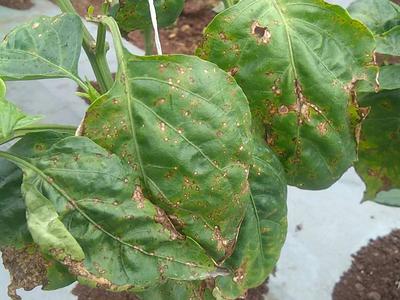Bacterial Spot of Pepper
Xanthomonas sp.
Bacteria
In a Nutshell
- Small, yellow-green lesions on young leaves.
- Dark, water-soaked lesions on older foliage with yellow circles.
- Deformed and twisted leaves.
- Water-soaked areas on fruit, becoming rough, brown, scabbed.
Can also be found in
Symptoms
The first symptoms are small, yellow-green lesions on young leaves, which usually appear deformed and twisted. On older foliage, lesions are rather angular, dark-green, and greasy in appearance, often surrounded by yellow circles. They are often more numerous on leaf margins or tips. Eventually, the spots look like shot holes because the center dries up and disintegrates. Fruit spots (up to 0.5 cm) start off as pale-green, water-soaked areas, which eventually roughen, becoming brown and scabbed.
Recommendations

Organic Control
Bacterial Spot is very difficult and expensive to treat. If the disease occurs early in the season, consider destroying the entire crop. Copper-containing bactericides provide a protective cover on foliage and fruit. Bacterial viruses (bacteriophages) that specifically kill the bacteria are available. Submerge seeds for one minute in 1.3% sodium hypochlorite or in hot water (50°C) for 25 minutes.

Chemical Control
Always consider an integrated approach with preventive measures together with biological treatments if available. Copper-containing bactericides can be used as a protectant and give partial disease control. Application at the first sign of disease and then at 10- to 14-day intervals when warm, moist conditions prevail. The active ingredients copper and mancozeb give a better protection.
What caused it?
Bacterial spot occurs worldwide and is one of the most devastating diseases on pepper and tomato crops grown in warm, moist environments. The pathogen can survive in association with seeds, either externally or internally as well as on specific weeds and later spreads through rain or overhead irrigation. It enters the plant through leaf pores and wounds. Optimum temperatures range from 25 to 30°C. Once the crop is infected, the disease is very difficult to control and can lead to total crop losses.
Preventive Measures
- Plant certified, disease-free seeds.
- Use resistant varieties if available in your area.
- Inspect fields regularly for signs of the disease.
- Remove and burn any seedling or plants with leaf spots, as well as adjacent plants.
- Remove weeds in and around the field.
- Mulch around plants helps to avoid soil to plant contamination.
- Clean tools and equipment after use if working between different fields.
- Avoid overhead irrigation and working in fields when foliage is wet.
- Plow plant debris deep into the soil after harvest.
- Alternatively, remove them and burn them.
- Plan a 2-3 year crop rotation with non-susceptible plants.



